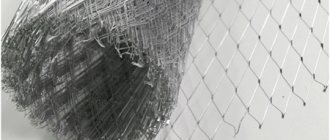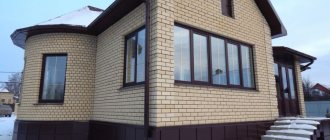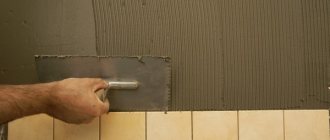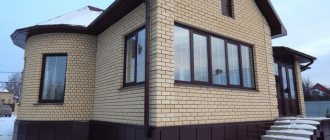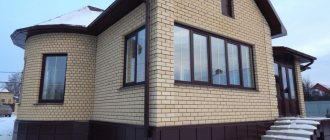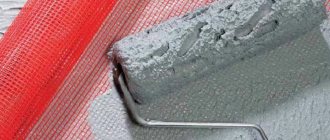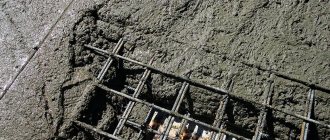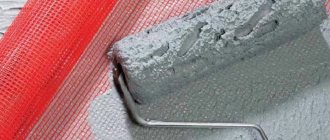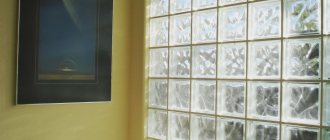Facade finishing is one of the most important construction operations. The coating of external walls is exposed to precipitation, cyclic freezing/freezing and exposure to harsh ultraviolet rays. Such difficult operating conditions place increased demands on the quality of finishing. Eliminating defects on façade walls is very expensive and time consuming. You will have to install scaffolding, wait for good weather, and remove construction debris. To eliminate the occurrence of unpleasant situations, you need to take all measures to prevent them.
Facade reinforcing mesh
Why do you need a reinforcing façade mesh?
Finishing of facade walls is carried out using various materials and technologies. Reinforcing stack is used in two cases.
To improve the performance characteristics of the plaster layer. For such purposes, it is better to use a metal mesh made of galvanized wire.
Galvanized welded mesh
Reinforcement is recommended to be used on façade walls made of foam concrete blocks; no additional measures are required for brick walls.
All metal mesh
The fact is that among the many advantages of foam blocks, you must definitely pay attention to one very significant drawback - low physical strength. Another problem is that concrete blocks begin to crumble when they freeze/thaw under conditions of high specific humidity. As a result, the cement plaster begins to peel off with all the negative consequences.
Foam block plaster
The reinforcing mesh allows the plaster to adhere to the wall surface. Conversations that such a mesh should be used when the plaster is thick, and that this prevents cracks from appearing on the plaster, are only partially confirmed. Firstly, there are simpler and cheaper methods to prevent cracks from appearing in thick plaster. The simplest one is to spread the solution in a thin layer in several stages. Secondly, the adhesion of the mortar to the façade wall can be increased by slightly increasing the amount of cement in the mortar. If this is not enough, then spray it with cement laitance.
To protect façade wall insulation from damage. Reinforcing facade mesh is used during the finishing of foam insulation boards.
Plastering on foam plastic
Not to improve the fixation of glue to the surface of polystyrene foam and to prevent cracks, as some “sofa” builders write, but precisely for mechanical protection.
Reinforcement
Why do we say this? The surface of expanded polystyrene is protected from the negative effects of ultraviolet rays and, oddly enough, damage from birds. For some unknown reason, birds are very fond of pecking at polystyrene foam; if you leave it unprotected, many large and small depressions will soon appear on the surface. Conclusion - polystyrene foam needs to be covered. The cheapest and most reliable method is to use glue.
By the way, the advertising characteristics of manufacturers of plastic reinforcing mesh “they are not afraid of UV” do not in any way affect their actual performance indicators. The fact is that even the thinnest layer of glue or other cement-sand mixture does not completely transmit ultraviolet rays. Why should the consumer pay for features that he does not need? And one more nuance. Most often, builders fix the reinforcing mesh on the entire wall. We think that this is done either out of ignorance of the physical properties, or by the desire to earn more money. We recommend using reinforcing mesh to a height of 1.5–2.0 meters; there is no need to go higher. No one will damage the finish screed on the foam that high. Mechanical damage occurs due to various impacts, careless maintenance work near the facade wall, etc.
Mesh for plastering walls: its types, selection rule
Hello dear friends! Today we will look at a very important component of facade finishing - a mesh for plastering walls. When insulating a house with thermal insulation material followed by plastering, one cannot do without the reinforcement process.
For this purpose, a special material is used - reinforcing mesh for plastering walls.
What is its purpose, is it possible to do without a construction mesh for plaster when performing the “wet facade” section, what types are offered today in the building materials markets and how to make a choice? We'll tell you below.
Properties:
- moisture resistance, resistance to temperature changes;
- low elongation and deformation rates;
- high tensile strength;
- low specific gravity, does not weigh down the structure;
- resistance to aggressive environments.
All these properties help to significantly improve the quality of thermal insulation, as well as significantly extend the service life of the thermal insulation and decorative layer. But all this cannot be done without first reinforcing the wall.
Types of reinforcing mesh
Fiberglass mesh - made of fiberglass, it is often used as a reinforcing mesh for plastering walls. Depending on the purpose they are classified into:
- conventional, used for the base layer of plaster;
- reinforced, used for reinforcing special structures, for example, when insulating foundations, basement floors, etc.;
- architectural, used for special architectural elements.
Metal mesh for plaster or galvanized mesh - this mesh has a long service life and can be used in finishing any facades. For example, metal mesh for plaster can be used when finishing a façade with tiles (they are heavy and require a strong reinforcing layer) or a plinth when finishing with stone.
And also when choosing a facade mesh for plaster, be sure to take into account its density. Since strength and other important physical characteristics depend on its density:
- up to 90g/m2 – for interior decoration and painting work;
- from 90 to 220 g/m2 - to strengthen the plaster of facades, we recommend using this mesh in thermal insulation work;
- more than 220g/m2 – to strengthen building elements subject to maximum load or located in the ground.
What does the color say?
Today in construction stores you can find fiberglass mesh for reinforcement in different colors. There are five basic colors: white, blue, green, orange, yellow.
Why do they come in different colors? Manufacturers do this so that meshes of different densities and with different cell sizes are visually different from each other, and the buyer can easily determine which mesh for plaster he needs and which mesh to choose.
For example, from one well-known manufacturer, orange fiberglass mesh has a density of 150 g/m2 and a cell size of 5x5 mm, white - 45 g/m2 and 2x2 mm, respectively. Today, when choosing, I would not focus only on the color of this product. Below we will describe the stages of selection; after reading this, you will be more prepared and will easily cope with the task of selection.
Choosing a façade mesh
When choosing a material for reinforcement when installing thermal insulation, you should pay attention to the following indicators:
- Density, it should be from 145 to 160 g/m2, the optimal size is 5x5 mm.
- Weaving quality and strength. To do this, just take a small piece and crumple it up. A good mesh should not tear, deform and quickly return to its original shape.
- Resistance to aggressive environments. The material must be treated with special alkali-resistant compounds.
- Price. As a general rule, the cost of reinforcing material should not exceed more than 5% of the total cost of insulation.
- Safety. Do not hesitate to ask the seller for a hygiene certificate.
Fiberglass mesh for facades is available in rolls of various lengths (usually 20 meters or 50 meters). The roll must be smooth and dense, and it must have a label indicating the manufacturer and characteristics of the material.
How to choose the right mesh?
Experienced builders have their own rules for choosing a grid, and we will tell you about them. It is imperative to check it for tensile strength. Take a piece of mesh in your hand and squeeze it; if it is of high quality, then it should return to its original shape - straighten.
First, you need to decide why you need it, what you will do: plaster, lay tiles, what is the thickness of the planned plaster, etc. Let's look at the choice using an example:
- If the layer of our plaster (finish) does not exceed 5 mm, then it is recommended to use fiberglass mesh for reinforcement. I almost forgot to say that the reinforced mesh for plaster evens out the wall we are working on a little more. It is clear that it cannot even out large differences, but it smooths out very well.
- Now let's consider the case when the plaster layer is more than 5 mm, then it is necessary to use a galvanized metal mesh, it will make the layer very strong. But be careful, we are talking about galvanized mesh, not steel mesh. Under no circumstances should steel be used for finishing facades, as it oxidizes (rusts) and can ruin everything for you.
- If you are already finishing the finishing and you have a final, thin layer left, then you can use a canvas with very small cells.
- If work is being done on a plasterboard surface, then a plastic grid will do.
Conclusion
Since the main purpose of the plaster mesh is to create a powerful reinforcing base for further fixing on it the entire mass of plaster or another option for the external decoration of the building’s facade, its choice must be taken seriously.
Imagine what will happen if you save on it and as a result all the decorative plaster cracks, which is significantly more expensive than even the most expensive façade mesh. Or, decorative tiles will start to fall off, which is also not cheap. There is only one conclusion - there is no need to save on facade mesh.
Source: https://ebtim.com/materialy/setka-dlya-shtukaturki.html
Types of façade reinforcing mesh
Facade mesh
Facade reinforcing mesh is made of galvanized wire or polymers. The former are used for facade plaster, and the latter are used for universal use.
| Name | Cell sizes, mm | Roll dimensions, m | a brief description of | Approximate cost, rubles |
| Safety | 2×2 | 1×50 | The material of manufacture is fiberglass, used to reinforce plaster near door and window openings, to level the joints of insulation boards | 900 |
| OXISS | 5×5 | 1×50 | The mesh has enhanced protection against alkalis and can withstand significant dynamic and static forces over a long period of action. | 1050 |
| Fiberglass mesh facade | 5×5 | 1×50 | For holding plaster on concrete facades and insulation boards. Withstands a tensile load of at least 1400 N/cm. | 1400 |
| STREN S5 | 22×35 | 2×25 2×50 | Withstands rough and finishing facade plaster up to 5 cm thick. | 2750 5500 |
| KREPIKS Facade 1300 | 4×4 | 1×50 | Fiberglass, protected from alkalis and ultraviolet radiation. | 1560 |
| KREPIKS Facade 1500 | 5×5 | 1×50 | Reduces the likelihood of cracks due to thermal linear expansion | 1970 |
| KREPIKS Facade 2000 | 4×4 | 1×50 | For reinforcing finishing plasters during finishing of the insulating layer of the facade | 2300 |
| Galvanized welded mesh | 6×6, Ø 0.6 mm | 1×15 | Increased strength, resistant to precipitation and sunlight | 1110 |
| Galvanized welded mesh | 10×10, Ø 0.8 mm | 1×15 | For rough façade plasters 3–5 cm thick | 1330 |
| Galvanized welded mesh | 25×25, Ø 1.0 mm | 1×25 | For strengthening facade walls, universal use. Hot galvanizing of wire, minimum coating thickness 20 microns | 1770 |
| TsPVS mesh | 20×20, Ø 0.5 mm | 1×25 | All-metal expanded metal. It has an increased contact area with the façade plaster solution. | 580 |
KREPIX 1800 5x4mm
Plaster mesh TsPVS
Modern facade mesh
Prices for construction reinforcing mesh
Construction reinforcing mesh
Is a façade mesh needed for plaster, its types and installation methods?
Facade finishing is one of the few construction processes that can not only give a more aesthetically pleasing appearance to a building, but also maximize the individuality of its occupants.
One of the most preferred materials for this type of work, from the point of view of the variety of colors and textures, is facade plaster.
It can be made on the basis of acrylic, silicone, liquid glass or cement, with each of the bases imparting its unique properties to the finishing composition.
It is worth noting that not a single type of facade plaster is applied directly to the wall itself; a special mesh is always laid between the finishing and the main structure (or insulation).
Why it is needed and how to choose it correctly will be discussed in our article.
The rationality of using facade mesh under plaster
Plaster finishing is one of the most ancient types of facing work, which, like any other work technology, has not been spared by technical progress.
For example, less than a century ago, printed wooden shingles were used as a layer between the plaster and the wall surface, which today has been replaced by a more practical and functional facade mesh.
The main functions performed by the façade mesh are:
- Reinforcement of the wall surface under the plaster mark;
- Additional hydro- and thermal insulation of the wall;
- Thanks to the strictly symmetrical arrangement of the threads, effective protection is achieved, preventing the formation of operational cracks and deformations in the finishing;
- The use of facade mesh allows you to create a more even layer of plaster;
- Serves as additional protection against external aggressive atmospheric influences on wall structures;
- The mesh reinforcing frame serves as a connecting link between the cladding and the wall , thanks to this material the solidity of the bond between the main structure and the plaster is achieved;
- Allows you to significantly extend the service life of facade plaster finishing.
Surface reinforcement
Types of facade mesh and their technical characteristics
Now let's talk about which grid is better to use. Depending on the base material, facade reinforcing meshes for plaster finishing are divided into:
Polymer facade
It is produced on the basis of such polymeric materials as nylon, polyethylene, polyvinyl chloride (PVC), etc. It can have both diamond-shaped and square cells.
The most common options for plastic meshes (according to cell size):
Diamond-shaped:
- FCF 10 (10x10 mm);
- FCF 12 (12x12 mm);
- FCF 15 (15x15 mm);
- FCF 25 (25x25 mm);
- FCF 50 (50x50 mm).
Square:
- SQ 10 (10x10 mm);
- SQ 15 (15x15 mm);
- SQ 30 (30x30 mm);
- SQ 40 (40x40 mm);
- SQ 50 (50x50 mm).
Syntoflex mesh, with cell:
- 12x12 mm;
- 14x14 mm;
- 22x22 mm;
- 35x35 mm.
Plurima. Has a cell size of 5x6 mm.
High-strength Armaflex mesh, with cell size 12x15 mm.
Universal:
- Small 6x6 mm;
- Average 14x15 mm;
- Large 22x35 mm.
Advantages of using polymer plaster mesh:
- Complete resistance to corrosion processes;
- The material is lightweight, its use does not require additional reinforcement of thin walls;
- It is produced in the form of rolls, which greatly simplifies its delivery to the construction site, as well as the installation process itself;
- Environmentally friendly material;
- Resistant to moisture;
- Can withstand a layer of plaster 5 cm thick without deformation.
Disadvantages of using polymer meshes:
- Deforms under the influence of high temperatures (up to complete melting);
- Not alkali resistant material.
- Cannot be used for plaster that requires a layer thickness of more than 50mm.
Metal
Made from thin metal rods.
In production, both high-alloy steel and ordinary carbon steel can be used; products made from non-ferrous metal alloys are less common (they are unprofitable because they have a high cost).
To improve performance characteristics, the metal can be coated with polymer compounds, zinc or tin paint (tinned steel).
Depending on the manufacturing method, the following types of metal mesh are distinguished:
- Expanded metal . It is made from a solid metal sheet by cutting out cells of the same size in it. Often used when plastering corners and buildings with complex architectural forms.
- Rabitz. It consists of many metal spirals that are woven into each other. Available with or without polymer or zinc coating.
- Welded mesh. It consists of small cross-section reinforcing bars connected to each other by spot welding.
Such meshes are divided into light ones:
- Reinforcement diameter 3-5 mm, class BP 1;
- Reinforcement diameter 5-6 mm, class A III;
Heavy: Diameter 8-40 mm, class A III.
For plastering walls, metal nets with a wire thickness of 3 mm and a cell diameter are used:
- 10x10 cm (product length per roll – 2 m);
- 15x15 cm (product length per roll – 3 m);
- 20x20 cm (product length per roll – 3 m).
Advantages of using metal mesh:
- High degree of adhesion;
- Simply cut into the required size pieces;
- If there is a protective coating, it can resist exposure to aggressive environments;
Disadvantages of use:
- If the protective surface is missing or damaged, corrosion processes may occur on the metal;
- It conducts current very well, so it cannot be installed near electrical networks;
- It has more weight than other types of facade plaster mesh.
Made from fiberglass
It is made from fiberglass threads and has a cell size of 5x5 mm.
Available in rolls with different colors.
Has a density of 145-160 g per square meter.
Advantages of using fiberglass mesh:
- Does not react with aggressive chemicals;
- Resistant to temperature changes;
- Rolls are light;
- Does not burn;
- Not an electrical conductor;
- Elastic;
- Resistant to ultraviolet radiation;
- Environmentally friendly material.
Disadvantages of use: none identified.
Areas of use
All of the above options for facade networks can be used not only when plastering surfaces, but also in the following cases:
- Protection of the building facade during finishing work;
- For the construction of fences, pens for small livestock;
- Sports fencing on tennis courts, ski slopes, golf courses;
- Decoration of balconies, loggias, verandas;
- Fiberglass mesh with a cell size of less than 5x5 mm is used for puttying walls;
How to choose the right mesh for plaster
To make the right choice of facade reinforcement, you need to pay attention to the conditions in which it will be used.
Thus:
- If the thickness of the plaster layer does not exceed 2 cm, then you can do without a façade network altogether;
- With a finishing layer thickness of 2-3 cm, it would be more rational to use fiberglass mesh;
- If the plaster is applied with a thickness of more than 3 cm, then the reinforcement should be done using a stronger metal mesh;
General rules:
- Weaving must be done with high quality, without defects;
- The edges of the rolls must be trimmed evenly;
- The packaging must be solid, each roll must have a label with information about the material;
Grid selection
Metal mesh fixation technology
Metal mesh is used only for cement-sand facade plasters; foam insulation is not finished with it. The reason is the small thickness of the screed on foam boards. But a metal mesh cannot be aligned with such precision; it must be pressed down with a thick layer of mortar. Metal façade reinforcing mesh can withstand great forces; it is used when it is necessary to apply a thick layer of plaster on an uneven base.
Metal facade reinforcing mesh
The algorithm for fixing it has several features, the implementation of which guarantees the expected effect. The mesh can be laid in both vertical and horizontal stripes. This does not matter for the strength of the plaster; decide for yourself how it is more convenient for you to work. How to properly fix a metal mesh to a façade wall?
Plaster metal mesh
Step 1 . Take the dimensions of the wall and cut the metal mesh along them. Select a cutting tool based on the wire diameter. A universal tool – metal scissors.
Metal scissors
If they are not there, then a thin mesh with a wire diameter of up to 0.8 mm can be cut with ordinary scissors. True, after this these scissors will have to be sharpened; they will no longer cut paper.
Prices for construction scissors for metal
Metal scissors
Step 2. The metal mesh can be fixed with dowels; the length of the hardware should ensure strong fixation. For facade walls made of foam blocks, you can use ordinary nails 80–90 mm long. They are easily hammered into blocks with an ordinary hammer, and working with them is much faster and easier. Nails are much cheaper than dowels, and the quality of fixation is no different. Use dowels only on brick or concrete facade walls.
Fastening to brickwork using a self-tapping screw with a wide washer
Step 3. Using an electric drill with a hammer drill, drill the first hole for the mesh. The depth of the holes should be several centimeters greater than the length of the plastic part. Otherwise, it is impossible to insert the dowel to the required depth - the hole fills a little with brick chips during drilling and reduces its effective depth. It is difficult to remove it from there; it is better to drill more.
Important. The height of the protruding part of the dowels should not exceed the thickness of the plaster mortar. Monitor this parameter over the entire area of the façade wall so that you don’t have to adjust the dowels during plastering.
Step 4. Drill holes along one line at a distance of about fifty centimeters, hang a mesh on each dowel. Pull it a little, do not allow large irregularities. The position of the line does not matter; it can be vertical or horizontal depending on the method of fastening the reinforcing metal mesh.
Step 5. Check the position of the opposite edge of the grid; if it lies unevenly, then move the grid onto adjacent cells.
Fastening the plaster mesh - diagram
Step 6. Everything is fine - continue to fix the mesh, install the dowels in a checkerboard pattern. Most metal mesh is one meter wide; to secure it you will need three rows of hardware.
Fastening metal plaster mesh to a brick wall
Fastening metal mesh to the wall
Important. Where two rolls overlap, install the dowels at a distance of approximately 10 cm from the edge. Two strips of reinforcing mesh will be hung simultaneously on these dowels.
Step 7. In the areas of window and door openings, the mesh is cut to size. But there’s nothing wrong if you don’t cut it off, but simply bend it. Just make sure that the edges of the bent sections do not protrude beyond the thickness of the plaster layer.
When plastering such a façade wall, the mortar must be applied in several stages. For the first time, the mass should be slightly thicker than for final leveling. Specific values depend on several indicators and are determined individually, taking into account the practical experience of the master. The consistency of the solution is influenced by the weather, the ability of facade walls to absorb moisture, the linearity of the wall, the maximum parameters of unevenness, etc.
The process of plastering a wall using a fixed metal mesh
Which mesh to choose for plaster?
No repair is complete without leveling the surfaces; plaster additionally provides protection, heat and sound insulation, thereby performing both aesthetic and practical functions. For the reliability and strength of the rough finish, a mesh is needed for plastering walls, ceilings, and floors, which secures the leveling layer and prevents the mortar from peeling and cracking.
Next, we will tell you what kind of construction mesh for plaster there is, and how to choose the right reinforcing layer.
Facade mesh for plaster, convenient method of installation on a mushroom dowel
Scope and types of reinforcing mesh for plaster
Previously, shingles were used to secure plaster, nails were often driven in, and later chain-link appeared. These traditional technologies have been preserved to this day, and along with them, new materials have appeared that significantly improve the quality of rough finishing and make the repair process easier and faster.
Today, reinforced mesh for plastering walls is presented in a wide range and its choice depends on the type of solution, layer thickness, area of application: exterior or interior decoration, and operating conditions: microclimate.
The plaster mesh is the basis of the leveling layer, which makes it reliable, resistant to mechanical stress, and capable of withstanding difficult chemical and biological operating conditions. Prevents peeling, bubbling and cracking of the solution.
https://www.youtube.com/watch?v=7TxzidvdkrY
Useful information: A simple metal mesh for plaster is not used in rooms with a humid microclimate, for example, in bathrooms, swimming pools and for exterior decoration.
Galvanized and fiberglass products are suitable here. A plastic mesh for plaster is unacceptable for cement mortar; over time, the components of the mixture corrode the PVC.
Synthetic mesh is convenient to attach to quick-drying solutions
What types of meshes are there for plaster – you can’t make a mistake when choosing
High requirements for the quality of repairs, new technologies in the preparation and finishing of surfaces, a variety of solutions based on cement, lime, gypsum with the addition of additives forced the construction market to respond with new auxiliary materials. Different types of plaster mesh are used for different purposes.
Metal
Traditionally, plaster metal meshes are used as a reinforcing layer: welded, woven, made by expanded metal.
Steel mesh for plastering walls, available with cells of different sizes. It consists of metal rods of different thicknesses, welded together at intersections.
A very durable product, with high physical and mechanical characteristics, but it is only suitable for interior decoration in rooms with a dry microclimate, since under the influence of humidity, corrosion can form on the mesh, which will lead to the destruction of the plaster layer.
Welded grating is an indispensable solution for thick layers of finishing
Galvanized mesh for plastering walls is the most popular option for external facade and basement work; it is not afraid of corrosive deposits. Cells from small to large, welded in knots.
Reinforcing mesh for plastering walls - chain-link, universal for a thick leveling layer, suitable for all types of mortars.
Thanks to the movable wicker system of nodes, it can be used not only for finishing surfaces made of brick, concrete, stone, but also for aerated concrete and wooden walls, where the material constantly works under the influence of climatic conditions. In addition, the chain-link is relevant in new buildings, where shrinkage of the walls is inevitable.
Chain-link – a traditional method of reinforcement for plaster
Expanded metal mesh for plastering walls is made in a special way. Holes are cut out of a whole sheet of metal under a press, then the sheet is stretched to produce diamond-shaped cells. The absence of welded joints gives the product strength; expanded metal mesh is used for plastering internal walls, for a thin layer of up to 30 mm.
New technologies
Along with metal products, meshes made of modern, synthetic materials are widely used to make the reinforcing frame of the leveling plaster layer.
For walls made of aerated concrete and brick, the best method is plastic masonry mesh for plaster, plastic with a small mesh, for finishing facades and plinths with a larger mesh. It tolerates large temperature deltas well, -40o-+100oC, and is suitable for use on a heat-insulating layer.
Fiberglass mesh for plastering external walls and interior decoration is made of glass without alkali impurities; an additional component is aluminum, which increases the mechanical strength of the canvas many times over.
It is not afraid of chemical and biological influences, does not rot, and is considered a universal material for all types of plastering work.
Fiberglass mesh for facade plaster is made of extra-strong fiber, can withstand thick layers of mortar, and can be used as insulation.
Mesh for plastering walls, photo of a thin fiberglass sheet, suitable not only for rough finishing, but also as a base for decorative plaster
Polyurethane mesh for plastering facades and rooms is available with cells of different sizes, is suitable for all types of mixtures, and can be used to reinforce thin and thick plaster layers. The material is lightweight, inert to various types of influence, the best solution for large areas, including industrial buildings, warehouses, and private homes.
Biaxially oriented polymer meshes are a new word in finishing materials. Lightweight, not subject to corrosive changes, not afraid of alkali, not an obstacle to the magnetic field, elastic, easily transformable to any base, therefore convenient for finishing curved and rounded structures.
Polymer mesh for plaster is an indispensable solution for finishing conductive communications, facades and interior work.
Ultra-strong polypropylene facade mesh for plaster can withstand thick layers of heavy cement compositions; the use of the product in the reinforcement of bridges and roads only confirms the strength of the material.
Mesh for plastering walls, photo of a polymer product
Secrets of the masters
The variety of types of reinforcing mesh for plaster sometimes confuses home craftsmen who carry out finishing work with their own hands. There are several simple rules that will help you figure out which grid and under what conditions is better to choose:
- For a layer thickness of up to 30 mm, it is recommended to give preference to fiberglass fabric punching sheet, which sits on a quick-drying solution and stabilizes the surface.
- Metal gratings are recommended for layer thicknesses of 30 mm and higher. Galvanized products are relevant for outdoor work, as well as in bathtubs and swimming pools.
- The plastic grid is suitable for plaster finishing, and the sheet with mini-cells is suitable for finishing with putty.
- For sealing seams and cracks - serpyanka, self-adhesive tape, it reliably protects the weak area, giving it strength.
- When reinforcing slopes under a thick layer of mortar, a metal grid should be used; for a thin layer, fiberglass should be used; even if the thickness of the plaster does not exceed 5 mm, slopes with a width of 150 mm or more must be reinforced.
- To finish the stoves, they use chain-link for a cement-clay layer and fiberglass for thin plaster.
A convenient way to fasten and reinforce corners
Source: https://FreshRemont.com/kakuyu-vybrat-setku-dlya-shtukaturki/
Step-by-step instructions for fixing plastic mesh
The durability of its operation largely depends on the correct implementation of recommendations for installing plastic reinforcing mesh on foam insulation. In all cases, do not rush, work carefully. We have already mentioned that there is no need to reinforce the entire wall height; it is enough to protect only the lower vulnerable area. But these are our recommendations; if you have doubts, protect the entire surface of the façade wall.
Fiberglass mesh
Any brand of glue is suitable for gluing the mesh. Study the instructions, it should have high adhesion to plastic materials. In most cases, a finishing layer of adhesive several millimeters thick is applied over the plastic reinforcing mesh. The final coating is done with facade paints or a thin layer of decorative plaster.
Glue for gluing fiberglass mesh to the facade
Step 1. Inspect the surface of the slabs. If they were fixed with dowels, then completely recess the caps and seal the recesses. You can close the gaps at the same time, but this is not necessary. The fact is that the cracks will automatically close during the application of the first layer.
Fastening sheets using umbrella dowels
Step 2. On the wall, draw a horizontal line along the height of the reinforcing layer. It will help you monitor the height of glue application. A thin layer of material dries quickly, and this not only causes an increase in material consumption, but also negatively affects the final leveling of the layer for painting.
Step 3: Prepare the glue according to the manufacturer's instructions. Always pour water into the container first, and then add the dry mixture. This technology will greatly simplify the mixing process. You can mix it manually with a trowel or using a mixing attachment for an electric drill.
Preparation of glue
The second method is not only easier, but also more effective. You need to stir for a few minutes, and then leave the mixture to stand for another 5-6 minutes. During this time, the moisture will be evenly distributed throughout the entire volume, and the smallest dry lumps of glue will completely disappear.
Step 4. The glue is applied to the wall with a spatula; the longer it is, the smoother the resulting surface is. Professionals work with spatulas up to 70 cm in size; beginners can initially use shorter ones.
Practical advice. If you are just learning how to apply glue to a surface, it is better to immediately get used to working with both hands. If one gets tired, use the other hand. Believe me, it is not so difficult, you just need to show a little endurance and patience.
Apply glue to the spatula with a trowel in the center of the tool. The quantity will be determined experimentally. While applying the layer, hold the spatula at an angle to the foam boards and press with medium force. Achieve a layer thickness of approximately 2–3 millimeters. Do not prepare a large amount of surface at once; for beginners, two meters in length is enough. If you do not have time to fix the mesh, the glue will harden, you will have to remove the old layer and make a new one.
Step 5. Try on the location of the plastic reinforcing mesh. If it does not fit into the window opening, trim the material.
Step 6. Glue one end of the mesh, align it horizontally to the length of the prepared section of the wall. Make sure that the mesh lies smoothly without distortions or bends; be guided by a pre-drawn line on the foam.
Practical advice. The mesh should overlap approximately ten centimeters. You may come across recommendations not to apply glue to the overlap of one line, but to do this simultaneously for two rows. We do not recommend doing this, it only complicates the work. Glue the first row of mesh along the entire width at once, including the overlap. The second line will be glued on top of the freshly applied glue. This method simplifies the fixation of the mesh and has a positive effect on quality.
We attach the mesh with overlapping fabrics
Step 7. Use your hand to press the mesh onto the fresh glue in several places and check its position again.
Cut off the excess
How is fiberglass mesh attached to polystyrene foam?
Step 8. Using a spatula, begin to press the mesh to the surface of the insulation. Make sure that the glue of the first layer extends over the entire surface and evenly covers the mesh cells on the front side. If there are areas where the adhesive is not thick enough, reapply it over the reinforcing mesh. Such omissions may appear in inexperienced craftsmen. Over time, you will learn to determine by eye the optimal thickness of the glue and there will be no more gaps. Spread excess solution over free surfaces. You shouldn’t try to immediately make the surface perfectly smooth, but you need to strive for this result.
Gluing the mesh
Gluing the mesh with a spatula
Step 9. Allow time for the glue to dry. It is better to leave it overnight; finishing grouting of surfaces is recommended the next day.
That’s all the technology is, the surface of the façade wall is prepared for painting or finishing with other materials. We remind you once again that plastic reinforcing mesh on insulated facades is not used to prevent cracks on the surface of the adhesive, but to prevent mechanical damage to the foam. Keep this in mind when making your decision.
Prices for popular types of putty
Putties
What types of plastic mesh are there?
When choosing this material, we should pay attention to its labeling. So, the letters PCF mean diamond shape, and SQ means square cells. Typically, a square mesh is chosen when performing reinforcement, while a diamond-shaped configuration is more typical for plastic mesh used as fencing. However, nothing prevents the use of both cell variations in reinforcement when carrying out plastering work.
The mesh density can also be very different. This parameter affects the strength of the product, and therefore its ability to withstand layers of plaster of different thicknesses. Models with the highest density can withstand even more than 5 centimeters of plaster, but it is still better to use stronger materials for this.
Facade mesh to protect construction sites
Compliance with safety regulations during construction work on multi-storey buildings is one of the main requirements for all developers. This is especially true for facilities built within cities. The façade mesh is fixed to scaffolding and prevents construction debris and tools from falling onto pedestrian walkways. For such purposes, the cheapest plastic reinforcing mesh is used; after dismantling, it is suitable for direct use.
Construction mesh
Facade mesh (half-sleeve mesh)
"Emerald" - a new mesh for scaffolding
How to choose the right mesh for wall reinforcement
The choice of material depends on various factors:
- composition of the plaster mixture;
- material of plastered structures;
- plaster thickness;
- operating conditions.
To reinforce cement-based plaster mortar, a mesh that is resistant to alkalis is selected. When using gypsum solutions, any reinforcing material will do.
It is not economically feasible to use heavy-duty, expensive imported reinforcing materials. It is better to opt for domestic meshes, which are not inferior in technical characteristics to foreign analogues.
Benefits of fiberglass reinforcement
Fiberglass reinforcing mesh is ideal for plastering walls inside and outside buildings for various purposes. Its advantages:
- has excellent adhesion to structures made of various building materials, all plaster and putty compounds;
- withstands heavy loads;
- resistant to aggressive atmospheric and chemical influences;
- protects the plastered surface from the formation of cracks.
- a large assortment allows you to choose any material to reinforce plaster of different thicknesses;
- the lightness of the material allows it to be transported in any car, while saving on transportation;
- does not pose a risk of injury during installation, unlike metal analogues;
- easy to cut and install.
Advantages of steel
Reinforcing plaster with metal mesh has become very popular due to the many advantages of the material:
- high strength, allowing to withstand heavy loads from thick plaster layers;
- Possibility of use on any base, except for structures made of plasterboard and hollow brick.
- You can even plaster metal by welding a steel grate to it;
- permissible plaster thickness is up to 50 mm.
Question answer
Is it possible to repair peeled areas with façade reinforcement mesh? It is possible, but it is better to avoid such situations. Unfortunately, in most cases, peeling appears several months or years after finishing the insulated façade walls.
Repair of peelings
How is the repair done?
- Inspect the peeled area. Using your hand, check the strength of the mesh fixation next to the detached area. Prepare materials: glue and a piece of plastic reinforcing mesh. If the facade walls are painted, then you need to have the appropriate paint.
- Pull the peeled mesh towards you and use a sharp mounting knife to cut it around the perimeter. Work very carefully, do not damage the foam. If the sect continues to flake off during cutting, great. In this way you remove the entire problem area; in any case, it would peel off over time.
- Cut a new mesh for the patch, the size should be slightly larger than the cleared area for the overlap.
- Remove the layer of old glue from the surface of the foam.
- Using a spatula, carefully remove the top layer of glue from the surface of the remaining mesh to the width of the new overlap. Apply the first layer of glue, embed the mesh into it and apply the second layer of glue.
- After it dries, level it. Pay special attention to the docking area. It should be as smooth as possible without sudden changes in height.
Repair of a peeling area
How does the quality of plastic mesh depend on its price? Almost nothing. When choosing a mesh, pay attention to the thickness of the fabric and the size of the mesh cells. All other characteristics are nothing more than advertising gimmicks of the manufacturers.
Plastic mesh
What is better than a plastic anti-corrosion coating for metal reinforced mesh against galvanizing? Nothing, besides, the price of such a mesh is higher than with galvanized wire. You need to know that the adhesion of all cement mortars to plastics is significantly lower than to galvanized surfaces. As for the service life and load-bearing capacity, these indicators are absolutely identical.
Metal mesh with polymer coating
Is it possible to do without reinforcing mesh when plastering uneven façade walls? Not only is it possible, but it is necessary. We have already talked about simpler and more effective methods of working with such surfaces. Reinforcement with metal mesh is used not to prevent the appearance of cracks, but to increase the bearing capacity of cement-sand mortars. It is needed when screeding the floor. One more nuance. The indicators of linear thermal expansion of metal and solution differ significantly. This means that microcracks will certainly appear in the places where cement and metal mesh meet, because outside temperatures fluctuate within significant limits. In enclosed spaces there are no such fluctuations.
Should I use reinforcing mesh on the basement surfaces of façade walls? Use this technology only for foam-insulated bases. In all other cases it is not needed.
Photo - a cake made of insulation and mesh for reinforcement
How much does the cost of finishing facade walls increase due to the use of reinforcing mesh? The cost of finishing increases by no more than 3–5%. But if we take into account possible repairs due to mechanical damage to the foam, then a slight increase in cost is completely justified.
Types of reinforcing mesh and its purpose
Since the mesh used for plaster should serve as a kind of frame, various materials were tested to act as a load-bearing structure. They required not only tensile strength, elasticity and durability, but also other properties. Not all building materials can pass the rigorous exam.
Of those that have survived, those that have already proven themselves and are widely used:
- metal mesh fabrics;
- reinforcing mesh made of fiberglass, polyurethane, fiberglass, polypropylene, lavsan;
- products made from modified basalt glass;
- shingles (for plastering wooden bases).
They are particularly demanding when it comes to materials for outdoor work. Let's talk in more detail about the properties and features of reinforcing mesh products made from different materials.
Plastic reinforcing mesh
Modern polymer materials are very different from the first plastics. Thanks to this, not only massive products appeared, but also mesh ones that demonstrate high strength. This is how a new material appeared for reinforcing masonry and plaster coating. Polymer mesh fabric is made from polyurethane or polypropylene (for example, Plurim). In some qualities these materials are superior to metal ones.
For example, the advantages of plastic plastering mesh are as follows:
- no fastening to the base is required, since polymer materials are lightweight;
- light weight of rolls, ease of transportation;
- moisture resistance (no corrosion or rust stains);
- no rotting;
- environmental friendliness;
- resistance to vibration loads and elasticity;
- retain properties when temperatures drop to – 40°C or rise to + 100°C;
- lower price than metal and fiberglass products.
Flaws:
- some plastics are not resistant to chemical “aggressors”;
- A layer of solution thicker than 6-8 mm cannot be applied on top of a plastic mesh product.
Polyurethane mesh for plaster is inert to chemicals, therefore it is allowed for use in industrial buildings.
Products are distinguished according to two main parameters:
- shape and size of cells;
- degree of density (the maximum allowed load on the plaster coating depends on this value).
Polymer network meshes come in two configurations. For reinforcement, fabrics with cells are used:
- square shape (the letters PCF or SQ are indicated in the marking);
- diamond-shaped.
The latter are easier to manage when plastering is done alone. For interior work, mesh fabrics with 5 mm cells are used, for facade work - larger ones (from 10x10 mm).
In terms of density, products with values ranging from 70 to 165 g/sq.m. are universally used.
There is no need to attach the polymer mesh to the base with additional devices. It is enough to apply a layer of plaster or adhesive mortar to the wall, apply and straighten the canvas, running a spatula along the top with slight pressure, and “drown” the product into the layer. There should be no areas on the surface uncovered with the plaster mixture.
Serpyanka is the thinnest of the meshes. The scope of use is not limited to the cases already described. Serpyanka is used to cover the places where window and door blocks are attached to the wall.
